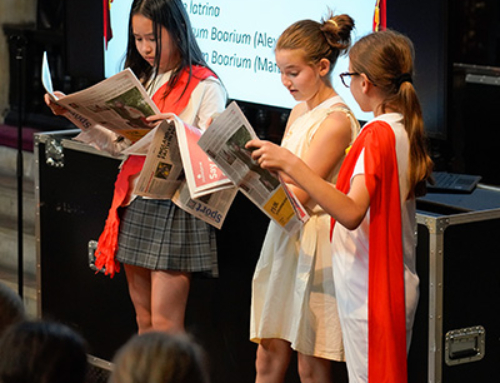This week, Ms Carr-Gomm discusses Antonello da Messina’s St Jerome in his Study.
This week, Years 10 and 12 have undoubtedly been heads down for their exams so it seems appropriate to look at a painting of a scholar hard at work, locked-down in his study.
Antonello da Messina, St Jerome in his Study, c1475, Oil on panel, 45 x 36 cm, National Gallery London
The painting can be viewed here.
We see St Jerome reading at his desk with great intent in a strange interior through a stoney opening that acts as proscenium arch. Even though this painting is tiny, theillusion of space is great and is created with light and shade and by the linear perspective of the majolica tiles and the architecture. To enter, we climb over a partridge, a peacock and a bowl of water to where someone, clever with a flat pack, has assembled the Saints study. He has taken off his shoes at the foot of the steps a bit carelessly given the neatness of the lovingly painted objects that surround him. There are ceramic vases and a bowl, some keys hanging up and some boxes and there are lots and lots of books. As the printing press was first established in Venice, where Antonello worked, in 1472, at about the same time this was painted, the books must have been painstakingly made by hand and they represent an impressive and highly valuable library.
The saint was of course a scholar, famous for translating the Bible from Greek into Latin in the 4th century; it was known as the Vulgate and is still in use today. He was made a Cardinal posthumously and he wears the red robes of his office with his hat placed behind him on the chest. There is a miniature and ghostly crucifix on the top of the shelf on the left to inspire him and the lofty vaults remind us of gothic cathedrals and provide a suitable setting for our saint. He sits solemnly enough but we are led out of the silence to happy scenes: swallows fly beyond the middle window and through the one on the left, we see a miniature landscape with horsemen, two people in a boat and some sheep.
Antonello clearly love to paint animals and some may be symbolic. Popular in themedieval age, Bestiaries described the characteristics of animals and these were likened to human qualities or to Christian figures but as information was gathered from different sources attributes can vary. The partridge was thought deceitful as it stole other birds’ eggs; a peacocks flesh never withered and therefore symbolises eternal life and here its beautiful feathers are down representing humility; the bowl ofwater on the right is the purification through baptism. Because of the way these objects are placed it is thought that Antonello is referring to good versus evil and, indeed, sitting tight on the step on the left is a cat, associated with the dark forces ofthe night. On the right, tiptoeing as quiet as a mouse, is a lion, from whose paw St Jerome plucked a thorn whereupon it became his devoted companion – a somewhat strange pet, it has to be said.














